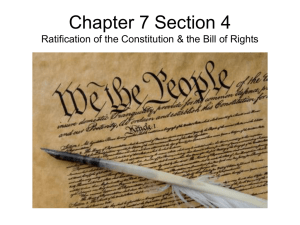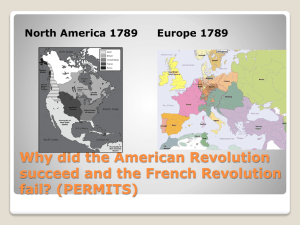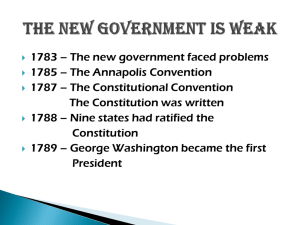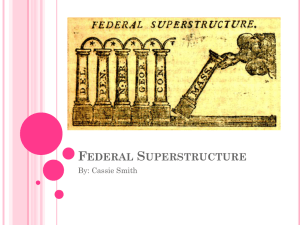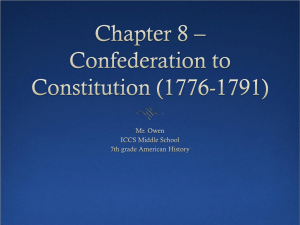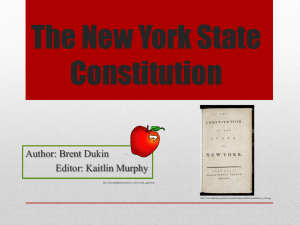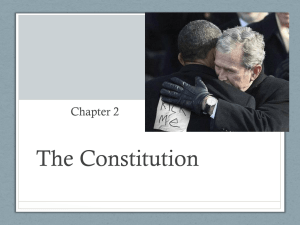Foundations of the American Democracy
advertisement
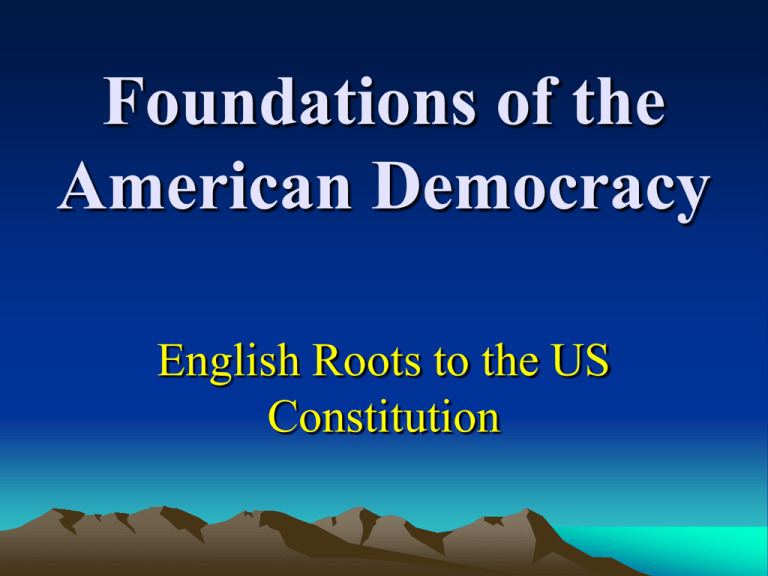
Foundations of the American Democracy English Roots to the US Constitution I. Colonial Democracy A. Traditions 1. Legislatures-people's voice in the government. These varied from colony to colony. 2. Protection of rights 3. Voting-privilege of the wealthy and educated. 4. Religious freedom-Roger Williams and Anne Hutchinson established. 5. Freedom of Press-John Peter Zenger case established. I. Colonial Democracy B. Roots-The American System derived from these main sources: 1. Ancient Greece and Rome 2. Magna Carta (1215)-limited the power of the king. 3. English Bill of Rights (1689)-Parliament listed the rights of all citizens. 4. John Locke-2 ideas: (1) 3 Natural Rights (2) Social Contract-consent of the governed. 5. Montesquieu-separation of powers prevented tyranny. II. The Articles of Confederation Several questions to be answered after the Revolution: Representation by population or equal representation? Division of power in the government? What to do with western lands? One Big Problem: Lack of Cooperation II. The Articles of Confederation A. Provisions 1. The Articles created a "loose union" of states where states' rights were important. 2. Created a unicameral legislature 3. Each state received one vote II. The Articles of Confederation B. Weaknesses 1. Too much emphasis on states' rights 2. Limited power to tax and raise an army 3. No president or court system to settle disputes between states 4. Total Lack of cooperation II. The Articles of Confederation C. Articles in Action 1. Unity between states diminished after the Revolution 2. *Northwest Ordinance of 1787 -Provided for a statehood process in western lands when population reached 60,000 -Prohibited slavery in these territories III. Changes in the New Nation A. Spain-still controlled the Mississippi and other western lands B. Shay's Rebellion-Massachusetts 1786 -Poor western farmers rebelled after being taxed by the local government -Led by Revolutionary war veteran Daniel Shay's C. Lack of Nationalist Outlook -People were still concerned with their local or state affairs. -Many local or state politicians were unsuccessful on the national level. D. III. Changes in the New Nation North Carolina after the Revolution 1. Before the war, 2/3 of the state’s trade was with Great Britain. 2. Large numbers of Loyalists were persecuted. Land was taken and sold to pay off debts 3. 1789-University of North Carolina established 4. Capital moved from New Bern to Raleigh in 1792. 5. North Carolina gives up western lands that became the state of Franklin and later became the state of Tennessee. III. Changes in the New Nation E. Constitutional Convention-May 1787, Philadelphia -All states were represented except for Rhode Island. NC sent William R. Davie, Richard Dobbs Spaight, William Blount, Alexander Martin, and Hugh Williamson. -Plan was to revise the Articles but that was impossible. -Delegates began to start over. IV. Drafting the Constitution Purpose: to Revise the Articles of Confederation. Decided start over. All done in secret. Debates: Small groups would become dominant in government Where should the power go: states or central government? IV. Drafting the Constitution A. Compromise 1. The Virginia Plan-drafted by James Madison"father of the constitution" -Bicameral legislature based on population -System of checks and balances between 3 branches of government so that no one part becomes too powerful. 2. The New Jersey Plan-drafted by William Patterson -called for equal representation IV. Drafting the Constitution 3. The Great Compromise-drafted by Roger Sherman big states vs. small states -House of Representatives-representation based on population -Senate-equal representation 4. 3/5 Compromise-slave states vs. free states -Slaves counted as 3/5 of a person for representation IV. Drafting the Constitution 5. Slave TradeAllowed to continues for at least 20 years 6. Electoral College-compromise on how we elect the president. Electors in each state cast votes for the President based on the popular vote in their state. IV. Drafting the Constitution B. Divided Power & Checks and Balances Delegated powers-national government Reserved powers-state government Central government is supreme Branches: Executive-can veto acts of Congress and appoints members of judiciary Legislative-can impeach president and confirms members of judiciary Judicial-can rule acts of Congress and president unconstitutional Amending: 2/3 vote of Congress 3/4 vote from states IV. Drafting the Constitution • Federalists • Antifederalists Supported the Constitution Opposed the Constitution Wanted stable central government Wanted to protect state rights The Federalist Papers • Alexander Hamilton, James Madison, and John Jay wrote essays supporting the Constitution that were published in newspapers. They were instrumental in the ratification of the Constitution. IV. Drafting the Constitution -By July 1788, 11 of 13 states had ratified. -NC voted 184 to 83 against the Constitution in July of 1788. -NC reconvened and voted 194 to 77 in favor of the Constitution. -Reasons for change: 1. James Madison introduced the Bill of Rights 2. George Washington elected as first president - Rhode Island ratified by May1790.





